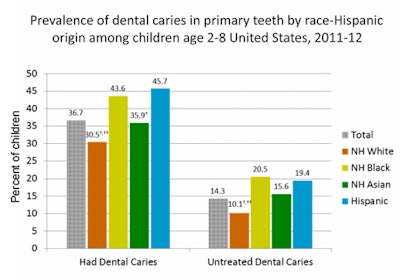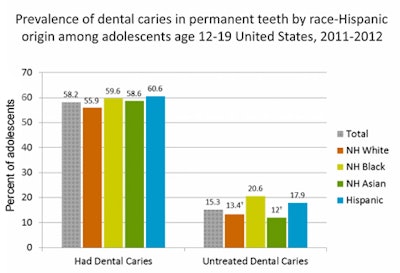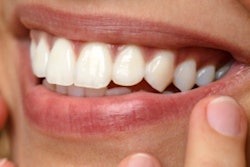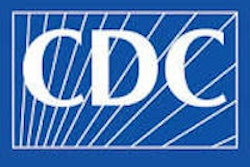
Almost a quarter of U.S. children between 2 and 5 years of age have caries in their primary teeth, according to a new report issued Thursday by the U.S. Centers for Disease Control and Prevention (CDC).
The eight-page report by the CDC's National Center for Health Statistics is based on data from the National Health and Nutrition Examination Survey, 2011-2012, and analyzed U.S. youth caries and sealant prevalence by race and Hispanic origin. Overall, disparities persisted in the U.S. for dental caries and sealant use among children and adolescents from 2011 to 2012, the report authors noted.
The survey included more than 3,300 children ages 2 to 19. Data were collected at the children's homes by trained interviewers and specially trained dentists who performed dental exams in mobile centers.

 Gina Thornton-Evans, DDS, MPH, dental officer, Oral Health Division, CDC, and Capt. Bruce Dye, DDS, MPH, dental epidemiology officer, NIDCR. Images courtesy of the CDC and NIH.
Gina Thornton-Evans, DDS, MPH, dental officer, Oral Health Division, CDC, and Capt. Bruce Dye, DDS, MPH, dental epidemiology officer, NIDCR. Images courtesy of the CDC and NIH.
Disparities in caries continue to persist for some race and ethnic groups in the U.S., especially among Hispanic, black, and Asian children, the report found. The prevalence of dental sealants also has varied among sociodemographic groups, noted report author Gina Thornton-Evans, DDS, MPH, dental officer in the CDC's Oral Health Division.
But there was some good news: Fifty years ago, 75% of children had caries in their adult teeth by age 11; now, only 25% of children have caries, noted report author Capt. Bruce Dye, DDS, MPH, dental epidemiology officer at the National Institute of Dental and Craniofacial Research (NIDCR) at the National Institutes of Health (NIH).
The following are key findings from the report:
- Approximately 23% of children ages 2 to 5 years had caries in primary teeth.
- Caries among children ages 6 to 8 was 56%.
- Untreated caries in primary teeth among children ages 2 to 8 years was twice as high for Hispanic and black children compared with white children.
- Among those ages 6 to 11, 27% of Hispanic youth had caries in permanent teeth, compared with nearly 18% of white and Asian youth.
- About 3 in 5 adolescents ages 12 to 19 had caries in permanent teeth, and 15% of these adolescents had untreated caries.
- For children ages 6 to 11, dental sealants were more prevalent for white children (44%) compared with black and Asian children (31% each).
Although caries has been declining in permanent teeth for many children since the 1960s, earlier findings showed caries in primary teeth for preschool children increasing from 24% to 28% between 1988 and 2004, Dr. Dye noted.
ADA response
The ADA had a generally positive response to the new statistics; however, they also called for the dental community to continue the fight against tooth decay.
"But even if the full study confirms a positive trend, the fact that dental decay still afflicts so many U.S. children is simply unacceptable," the association said in a statement. "While treating dental disease is critical, prevention is the ultimate answer."
“Disparities in caries continue to persist for some race and ethnic groups in the United States.”
Prevention is really the key to most of the issues raised in the report, ADA spokesperson Lindsey Robinson, DDS, told DrBicuspid.com in an interview.
Educating parents and communities on how cavities occur in children is another important part of the process, she said. Making communities aware of the importance of public health measures that improve oral health for children, such as a school-based sealant program, also would help.
Both Drs. Robinson and Thornton-Evans stressed the importance of helping communities understand the benefits of community water fluoridation. Dr. Robinson noted that her pediatric practice is in a small town, Grass Valley, CA, that lacks fluoridated drinking water.
She also noted that parents should ensure that children get at least one preventive dental visit a year. "As a pediatric dentist, I really appreciate their [general dentists'] efforts in preventing caries for young children," Dr. Robinson added. "We need to keep in mind that this is national data, and there are communities where tooth decay in young children is highly prevalent. My community is one of those."
Many dentists work in federally qualified health centers (FQHCs), she noted.
"The ADA encourages contracting between FQHCs and dentists to expand the ability to care for underserved populations," Dr. Robinson said. "Private dentists can actually see the patients from the health center, and the health center will take away the burden of the paperwork."
Caries in children's primary teeth
About 37% of children ages 2 to 8 had experienced caries in primary teeth from 2011 to 2012, according to the report. Caries prevalence was higher for Hispanic (46%) and black (44%) children compared with white kids (31%) in this age group. Asian children were less likely to have experienced caries (36%) compared with Hispanic children (46%).
 All images courtesy of the CDC.
All images courtesy of the CDC.During the two-year period in the survey, 14% of children ages 2 to 8 had untreated tooth decay in primary teeth. Untreated caries in primary teeth was nearly twice as high for children ages 6 to 8 (20%) compared with children ages 2 to 5 (10%). Caries was significantly higher for both black (21%) and Hispanic (19%) children compared with white children ages 2 to 8 (10%). The prevalence of untreated caries in primary teeth in Asian children did not significantly differ from that in any of the other race groups.
Caries in adolescents' permanent teeth
Among all adolescents ages 12 to 19, 58% had experienced caries in permanent teeth from 2011 to 2012. The prevalence of caries was higher among adolescents ages 16 to 19 (67%) compared with those who were ages 12 to 15 (50%). Overall, the percentage with caries did not significantly differ by race among adolescents.

Some 15% of adolescents ages 12 to 19 had untreated caries in permanent teeth from 2011 to 2012. Untreated caries was higher among adolescents ages 16 to 19 (19%) compared with those ages 12 to 15 (12%). Untreated caries was higher for black adolescents (21%) compared with white (13%) or Asian (12%) adolescents.
Prevalence of dental sealants among young children and adolescents
Nearly one-half of youth ages 9 to 11 had at least one dental sealant on a permanent tooth, and 31% of youth ages 6 to 8 had a dental sealant. Black and Asian youth ages 6 to 11 (31%) had lower dental sealant prevalence compared with white youth (44%). Hispanic youth (40%) had higher dental sealant prevalence compared with black youth ages 6 to 11 (31%).
From 2011 to 2012, 43% of adolescents ages 12 to 19 had at least one permanent tooth with a dental sealant. Sealant prevalence was similar among both adolescent age groups (43%). Dental sealant prevalence was significantly lower for black adolescents (30%) compared with white (47%), Hispanic (40%), or Asian (43%) adolescents ages 12 to 19.



















